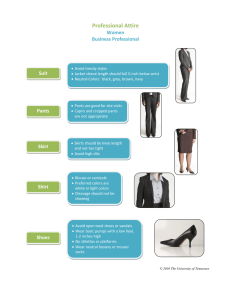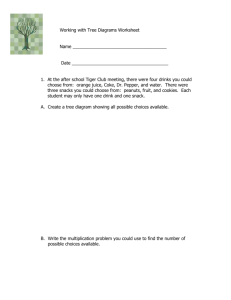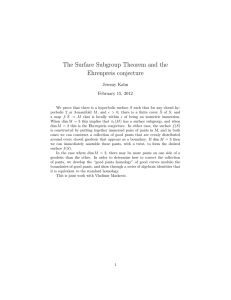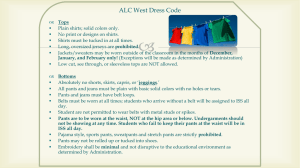T Fire Design Changes for Firefighter Pants Technology & Development
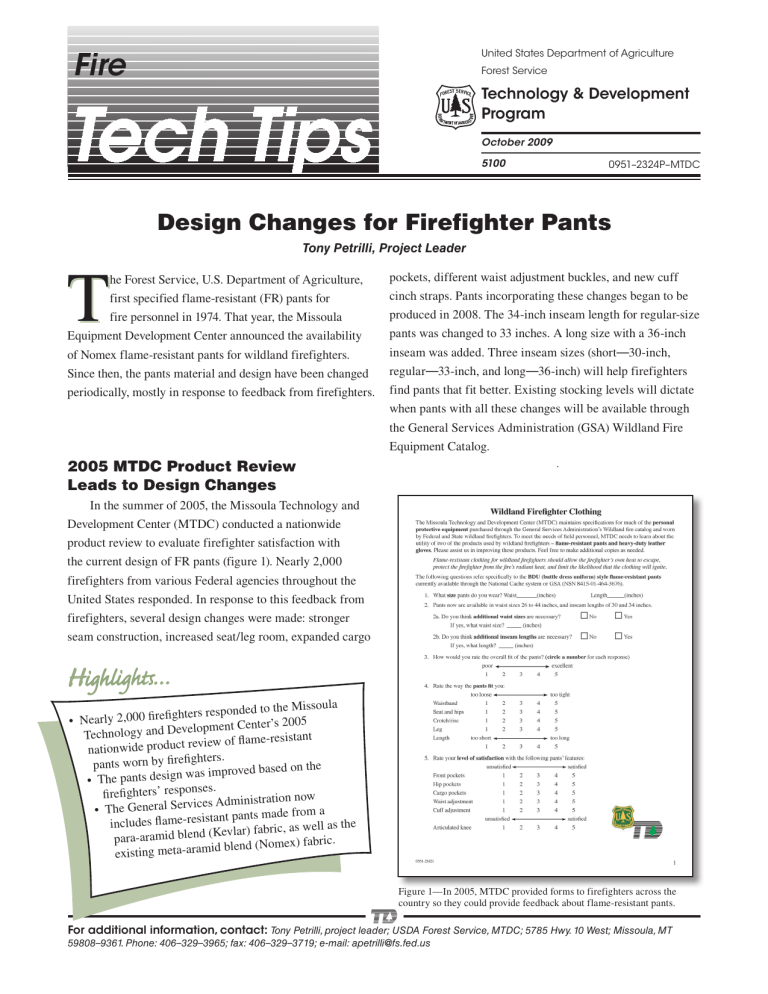
Fire United States Department of Agriculture
Forest Service
Technology & Development
Program
October 2009
5100 0951–2324P–MTDC
Design Changes for Firefighter Pants
Tony Petrilli, Project Leader
T he Forest Service, U.S. Department of Agriculture, first specified flame-resistant (FR) pants for fire personnel in 1974. That year, the Missoula
Equipment Development Center announced the availability pockets, different waist adjustment buckles, and new cuff cinch straps. Pants incorporating these changes began to be produced in 2008. The 34-inch inseam length for regular-size pants was changed to 33 inches. A long size with a 36-inch inseam was added. Three inseam sizes (short — 30-inch, of Nomex flame-resistant pants for wildland firefighters. regular — 33-inch, and long — 36-inch) will help firefighters Since then, the pants material and design have been changed find pants that fit better. Existing stocking levels will dictate periodically, mostly in response to feedback from firefighters.
when pants with all these changes will be available through the General Services Administration (GSA) Wildland Fire
Equipment Catalog.
.
2005 MTDC Product Review
Leads to Design Changes
In the summer of 2005, the Missoula Technology and
Development Center (MTDC) conducted a nationwide product review to evaluate firefighter satisfaction with the current design of FR pants (figure 1). Nearly 2,000 firefighters from various Federal agencies throughout the
United States responded. In response to this feedback from firefighters, several design changes were made: stronger seam construction, increased seat/leg room, expanded cargo
• Nearly 2,000 firefighters responded to the Missoula
Technology and De
nationwide product re view of flame-resistan
pants worn by firefighters.
• The pants design was impr t oved based on the firefighters’ responses.
• The General Services
Administration now includes flame-resistant pants made f rom a
para-aramid blend (K evlar) fabric, as well as the
existing meta-aramid blend (Nome x) fabric.
Figure 1—In 2005, MTDC provided forms to firefighters across the country so they could provide feedback about flame-resistant pants.
For additional information, contact: Tony Petrilli, project leader; USDA Forest Service, MTDC; 5785 Hwy. 10 West; Missoula, MT
59808–9361. Phone: 406–329–3965; fax: 406–329–3719; e-mail: apetrilli@fs.fed.us
2005 and 2006 Field Trials for New Fabrics
In 2005, MTDC also began evaluating alternative fabrics for use in FR pants. Five new fabrics were chosen for wear testing. The current fabric was included as the experimental control. The six wear-test fabrics were:
A—Current fabric, Nomex (meta-aramid) blend, (Forest
Service Specification 5100-88 Type I) 7.5 oz/sq. yd, twill weave, wicking finish
B—Kevlar (para-aramid) blend, 7.0 oz/sq. yd, ripstop weave, durable water-repellent (DWR) finish
C—Nomex (meta-aramid) blend, ripstop weave, wicking finish
D—Nomex (meta-aramid) blend, ripstop weave, durable water-repellent finish
E—Nomex (meta-aramid) blend, smooth ripstop weave, wicking finish
F—Indura FR cotton blend, 11 oz/sq. yd, plain weave
The 2005 product review identified two improvements firefighters wanted in FR pants: better protection from certain types of vegetation, such as brush and briars, and better thermal comfort in hot weather conditions, to reduce the likelihood of heat stress.
Evaluators thought the FR cotton pants provided the most protection from brush and briars. However, two characteristics led to FR cotton fabric being eliminated from further consideration. The FR cotton readily absorbed water and took a long time to dry. Evaluators also thought the fabric was too hot.
The Kevlar (para-aramid) blend received the second highest rating for protection from brush and briars. This blend had the second “coolest” rating of any fabric tested; only the current fabric was rated cooler. These factors make this fabric the best candidate for offering firefighters increased protection from brush and briars. This fabric also:
• Was more comfortable in cooler weather
• Had higher heat protection ratings during thermal and radiant tests
• Was requested by many firefighters
Forest Service specification (5100-92) for FR pants has been revised to include the para-aramid blend fabric. The
5100-92 specification now includes Type I pants, made with the meta-aramid blend (Nomex) fabric, and Type II pants, made with the para-aramid blend (Kevlar) fabric.
2
New Firefighter Pants Available Now
The 2009 GSA catalog includes the current meta-aramid blend (Type I, $75.54) pants and a brief announcement of the new para-aramid blend (Type II, $119.89). Both types incorporate the new design features described earlier (figure
2). Initially, the Type II pants will be available only in the most used sizes. Other sizes will be available later. The two choices of fabrics provide firefighters with greater flexibility to match their clothing to the diverse environments where firefighters may work, given their national mobility and extended fire seasons.
Forest Service funds can be used to purchase these pants only when they are ordered from the GSA Wildland Fire
Equipment Catalog or the Wildland Fire Equipment section of GSA Global Supply (http://www.gsaglobalsupply.gsa.gov).
The specific NSN (National Stock Number) ordering number
(table 1) must be provided when ordering the pants. For more information on ordering the Type II pants, go to the GSA
Fire Program Web page (http://www.gsa.gov/fireprogram).
Table 1—Type II (para-aramid blend) pants available through the GSA. The inseam lengths are short (30-inch) and regular (33-inch). Other sizes will be available later.
GSA ordering number
8415-01-559-3540
8415-01-559-3545
8415-01-559-3543
8415-01-559-3542
8415-01-559-3544
8415-01-559-3549
8415-01-559-3547
8415-01-559-3541
8415-01-559-3548
8415-01-559-3546
Waist size
(inches)
28–32
Inseam length
Regular
28–32 Short
30–34 Regular
30–34 Short
32–36
32–36
Regular
Short
34–38 Regular
34–38 Short
36–40 Regular
36–40 Short
Figure 2—Type II flame-resistant pants made of a para-aramid blend in a rip-stop weave are now available through the General Services
Administration.
The Future
Firefighters are participating in field trials to evaluate lighter weight fabrics in new material blends as a possible replacement for the Type I pants material. The goals are increased thermal comfort in hot weather, improved durability, lower costs, and overall firefighter satisfaction.
3
About the Author
Tony Petrilli is an equipment specialist for the fire and aviation and safety and health programs at MTDC. He has a bachelor’s degree in education from Western Montana College. Petrilli began working for the Forest Service in 1982 and joined MTDC full time in 2000. He has worked as a firefighter for the Lewis and Clark and Beaverhead National Forests and as a smokejumper for the Northern Region. He is a division/group supervisor, type III incident commander, and has served on more than 20 fire entrapment review or investigation teams.
Library Card
Petrilli, Tony. 2009. Design changes for firefighter pants. Tech Tip 0951–2324–MTDC. Missoula, MT: U.S. Department of Agriculture, Forest Service, Missoula Technology and Development Center. 4 p.
Nearly 2,000 firefighters responded to the Missoula Technology and Development Center’s 2005 nationwide product review of flame-resistant pants worn by firefighters. Design changes based on the firefighters’ responses included stronger seam construction, expanded cargo pockets, different waist adjustment buckles, and new cuff cinch straps. Six fabrics for firefighter pants were field tested during the 2005 fire season. Based on the field tests, the para-aramid (Kevlar) blend fabric was added to the Forest Service’s specification for flame-resistant pants. The General Services Administration will now include flame-resistant pants made from a blend including para-aramid fibers (Kevlar) as well as the existing blend that includes meta-aramid fibers (Nomex).
Keywords: clothing, fabrics, fire fighting, firefighting, flame resistant, FR, Kevlar, meta-aramid, Nomex, para-aramid, specifications
Additional single copies of this document may be ordered from:
USDA Forest Service
Missoula Technology and Development Center
5785 Hwy. 10 West
Missoula, MT 59808–9361
Phone: 406–329–3978
Fax: 406–329–3719
E-mail: wo_mtdc_pubs@fs.fed.us
For additional technical information about firefighter pants, contact Tony Petrilli at MTDC:
Phone: 406–329–3965
Fax: 406–329–3719
E-mail: apetrilli@fs.fed.us
Forest Service and Bureau of Land Management employees can search a more complete collection of
MTDC’s documents, CDs, DVDs, and videos on their internal computer networks at: http://fsweb.mtdc.wo.fs.fed.us/search/ Electronic copies of MTDC’s documents are available on the Internet at: http://www.fs.fed.us/eng/t-d.php
The Forest Service, United States Department of Agriculture (USDA), has developed this information for the guidance of its employees, its contractors, and its cooperating Federal and State agencies and is not responsible for the interpretation or use of this information by anyone except its own employees. The use of trade, firm, or corporation names in this document is for the information and convenience of the reader, and does not constitute an endorsement by the Department of any product or service to the exclusion of others that may be suitable.
The U.S. Department of Agriculture (USDA) prohibits discrimination in all its programs and activities on the basis of race, color, national origin, age, disability, and where applicable, sex, marital status, familial status, parental status, religion, sexual orientation, genetic information, political beliefs, reprisal, or because all or part of an individual’s income is derived from any public assistance program. (Not all prohibited bases apply to all programs.) Persons with disabilities who require alternative means for communication of program information (Braille, large print, audiotape, etc.) should contact USDA’s TARGET Center at
(202) 720-2600 (voice and TDD). To file a complaint of discrimination, write to USDA, Director, Office of Civil Rights, 1400 Independence Avenue, S.W., Washington, D.C. 20250-9410, or call (800) 795-3272
(voice) or (202) 720-6382 (TDD). USDA is an equal opportunity provider and employer.
4
